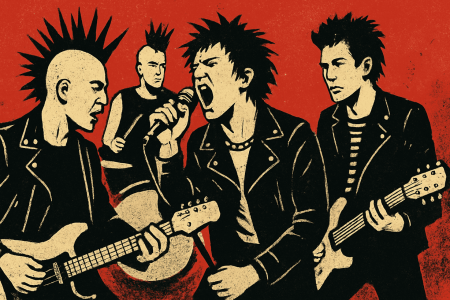Punk has always had a look. Torn clothes, loud guitars, and a middle finger to the mainstream. From the outside, it screamed rebellion. But behind the noise and chaos, a question still lingers: Was punk really anti-establishment, or was it just another style to sell?
Some bands wanted to burn it all down. Others seemed fine cashing in on the chaos. The lines between protest and profit got blurry fast. This wasn’t just music—it was a movement, or at least it claimed to be.
So what was punk really about? Was it a raw reaction against the system, or a well-marketed pose dressed up as anarchy?
The Birth of Punk: Chaos with a Cause?
Punk didn’t start in boardrooms or marketing meetings. It came from the underground, where frustration met volume. In the mid-1970s, two scenes lit the fuse: New York City and London.
In NYC, bands like The Ramones stripped rock down to its bones. Fast, raw, and loud, they didn’t care about solos or polish. Over in London, things got nastier. The Sex Pistols made headlines as much as they made music. Their sneers and scandals weren’t just noise—they were a statement. Then came The Clash, who mixed punk’s speed with sharp political messages.
So what drove them? Some just wanted to play fast and be heard. Others had a clear target: the system, the state, the status quo. Whether it was art, anger, or both, the early days of punk were messy, loud, and impossible to ignore.
Anti-Establishment in Spirit
At its core, punk wasn’t built for charts or radio. It was made in basements, not boardrooms. Bands recorded on cheap gear. Fans printed zines on stolen photocopiers. Everything about punk screamed DIY—because no one else was going to do it for them.
Independent labels like SST, Rough Trade, and Dischord gave bands control. They didn’t need industry approval. Punk created its own lane.
Lyrically, the message was just as clear. Songs went after corrupt governments, greedy corporations, and the dull pressure to fit in. No subject was off-limits. Punk called out everything and everyone, including itself.
More than music, it was a network. Local shows. Shared gear. A scene that ran on passion, not profit. While major labels chased hits, punk built a community—raw, real, and often ignored by the mainstream.
Enter the Industry: Co-opted or Evolving?
It didn’t take long for the industry to catch on. Punk’s energy was too loud to ignore. Major labels, once dismissive, started signing bands. Raw sound suddenly had marketing potential.
The Sex Pistols became the face of this shift. Their manager, Malcolm McLaren, knew how to stir chaos—and how to sell it. With a background in fashion and a sharp eye for headlines, he shaped the Pistols into a perfect storm. Rebellion was real, but so was the branding.
Some saw this as punk’s sellout moment. Others saw it as evolution. If the message reached more people, did it matter who was funding it?
Still, as punk moved from the underground to the spotlight, it lost something. The same system it aimed to tear down was now cutting the checks. The question became harder to ignore: was punk still fighting the machine, or just another part of it?
Merch, Image, and Marketability
Punk didn’t just sound different. It looked different too. Ripped shirts, spiked hair, safety pins through skin—at first, it was a rejection of fashion. But it didn’t take long before that look hit the runway.
What started as DIY became display. Big brands borrowed punk’s edge, sold it back with a price tag, and called it style. Band tees became staples. Chains and combat boots landed in high-end shops. Even rebellion had a SKU number now.
The anger stayed, but it got packaged. Labels pushed the image as much as the music. Punk wasn’t just a sound—it was a brand. And for some, that shift was the point where the movement lost its bite.
The question stood: if you can buy the look, can you still believe in the message?
Post-Punk & Hardcore: Course Correction or Deeper Dive?
As punk gained attention, some fans and bands pushed back. They didn’t want glossy magazine spreads or major label deals. They wanted noise, truth, and no filters.
Hardcore punk hit first. Bands like Black Flag, Minor Threat, and Dead Kennedys played faster, louder, and angrier. Shows were small, often in basements or community halls. The goal wasn’t fame—it was impact.
Then came anarcho-punk. Groups like Crass didn’t just write songs—they lived the message. Anti-war, anti-capitalist, anti-everything. They printed their own records, made their own gear, and stayed as far from the mainstream as possible.
These subgenres weren’t just musical shifts. They were corrections. A way to drag punk back to its roots. Whether that worked is up for debate. Some say the scene had already sold out. Others argue this was punk’s true form—still alive, just harder to find.
The Punk Paradox
So, was punk really anti-establishment—or just another trend?
The truth sits in the middle. Some bands meant every word. They lived the message, built their own spaces, and stayed far from the spotlight. Others played the part, cashed the checks, and let rebellion become a costume.
Punk’s strength was never in being pure. It was in being loud, messy, and impossible to ignore. It challenged the music industry not by playing the game better, but by refusing the rules entirely. Even when the system swallowed parts of it, punk changed what the system could look and sound like.
That’s the paradox. Punk fought the machine, but also fueled it. And in doing both, it left a mark that never really washed off.
